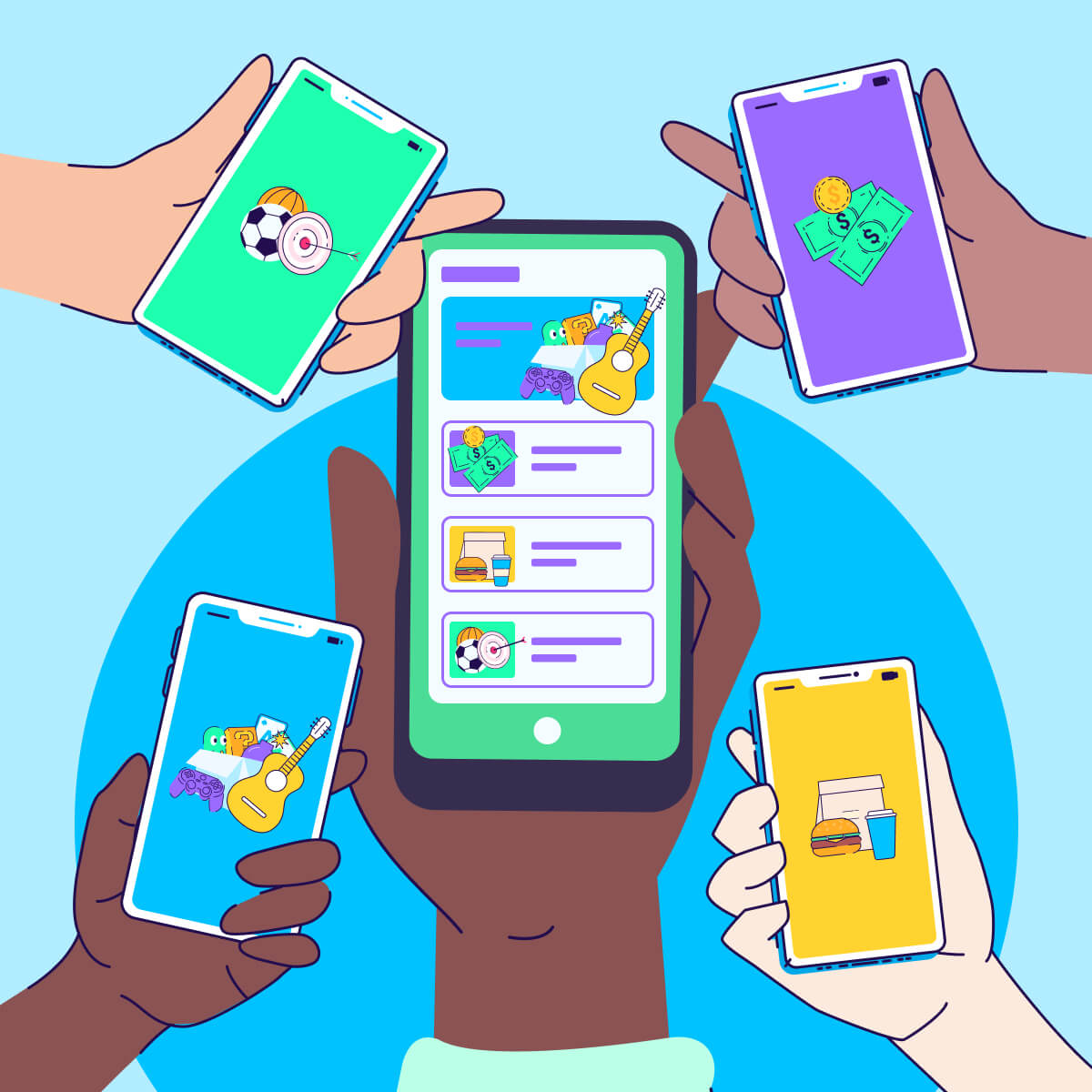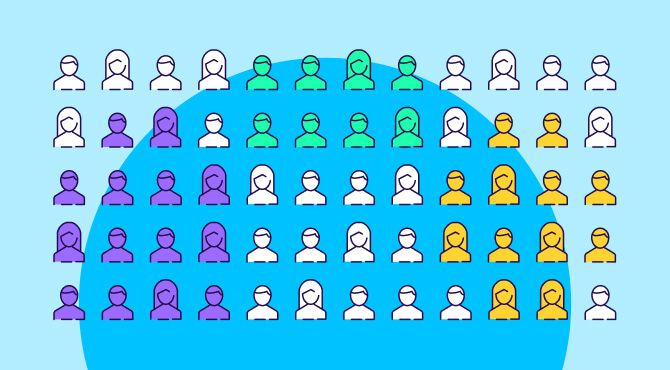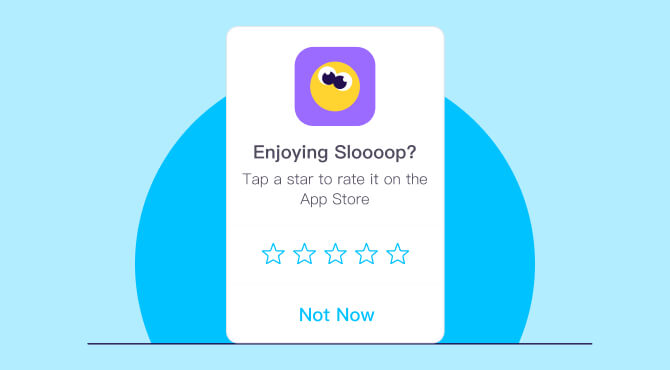What is app personalization, and why is it important?
App personalization customizes the user experience based on data, so it’s tailored to individual needs. This is important for boosting engagement, retention, and revenue.
Try searching for

Back in the day, mobile app product managers could get away with offering the same experience to everyone, regardless of what individual users wanted.
That’s no longer the case today.
Tired of generic app interactions, users want personalized experiences. In fact, 71% of shoppers expect businesses they buy from to recognize them as individuals and know their unique interests. They want to see content that interests them and receive relevant notifications.
With such high demand, it’s no surprise that mobile app personalization has become the most important mobile marketing trend. But how exactly do you go about it?
In this guide, we’ll delve deeper into effective app personalization. Read on to learn what makes it crucial for your marketing strategy, and get proven personalization tips (with real-world examples) to better connect with users and experience true growth.
App personalization involves customizing your mobile app’s content, design, and user experience to better fulfill your ideal user’s needs and preferences. It helps you make a solid impression on users, ultimately boosting customer retention and revenue.
But you can’t personalize your app without the right user data.
You need relevant information relating to your target audience’s demographics, location, and interests. This will help you deliver a highly personalized in-app experience in the form of app content, push notifications, recommendations, special offers, and more.
The mobile app space is a saturated one, with over 3.5 million apps in the Google Play Store and 1.6 million in the Apple App Store. Add other app marketplaces to the mix and you’ve got yourself a grand total of nearly 9 freakin’ million!
If your app somehow manages to stand out and get users to hit ‘Install‘, the average smartphone owner uses just nine to ten apps a day and 30 apps over a month. It’s this stiff competition that creates a need for app personalization.
By providing tailored experiences, you can enhance your app’s user experience (UX) so it meets (or even exceeds) user interests and preferences. This will help your app stand out from the crowd and get users to spend more time using it.
In turn, this increases the likelihood of them returning to the app in the future and becoming loyal customers.
The terms may sound similar, but app personalization is not the same as app customization, or segmentation. Let’s explore the differences.
App personalization is all about tailoring customer experience based on the data you collect from users. On the other hand, customization involves allowing the customers to make changes themselves based on their preferences.
So, the person creating the tailored experience is different for personalization and customization.
Additionally, personalization is implicit or implied. This means companies can make changes to deliverables based on the customer’s implied preferences. But customization is explicit, in that users clearly express what they want when making choices that influence their experience.

In terms of app personalization and app segmentation, the main difference is the focus.
Mobile app marketers use segmentation to identify specific types of audiences based on psychographics, demographics, location, behaviors, and technology usage. Using this information, marketers can then deliver relevant marketing materials to different groups (or segments) to achieve their app marketing goals.
Personalization is more customer-centric, focusing on the customers within each segment or group. It’s about understanding what each customer wants and delivering a tailored and unique experience based on their individual intent.
The main reason app personalization is worth implementing is it improves app performance and revenue generation. It’s a shortcut of sorts to achieve your goals through greater customer awareness, improved retention, and increased engagement, among other things.
Let’s take a more in-depth look at the key benefits of app personalization:
As a customer, which would you rather have: a bland app with generic products and irrelevant offers, or one that caters to your unique interests and shopping history?
The choice is a no-brainer, right?
Personalization is the key to delivering a top-notch customer experience through your mobile app. By tailoring your app to each user’s preferences and past behavior, you can create a seamless and enjoyable experience that keeps them coming back for more.
Moreover, personalization forces product managers to think like their users, making sure the app is easy to navigate and use. This leads to a more convenient, efficient, and enjoyable experience for the customer, ultimately increasing overall satisfaction.
Through personalization, you can significantly boost brand loyalty among your existing users.
Customer loyalty has many benefits that go beyond repeat sales. For example, loyal customers are more likely to recommend your app to friends and family, and even to strangers on their social media. They also engage with your app frequently and are likely to leave positive app ratings and reviews.

All this leads to a solidified market position and increased revenue to further fuel your app’s growth.
The better your app caters to your target audience’s specific interests, the more they’ll keep coming back instead of ignoring or abandoning your app.
As part of the personalized experience, you can share relevant offers, useful recommendations, and attractive discounts to make users feel valued. Identify and personalize your app based on what appeals to your users, and you’ll quickly gain a competitive edge in an oversaturated market, with lower churn and higher retention.
To personalize your app, you need a large amount of customer data. This means determining who your ideal users are and what they specifically enjoy about your app.
Collecting data also gives you valuable insights into your customer’s biggest pain points and preferences. Think: what’s the one thing about your app that attracts users to it? What are some areas that could benefit from improvement? When do people use your app?
Using this in-depth information, you can then make informed decisions and hyper-personalize your app content for better results. For example, you can send out relevant information to users about events and updates they want to see, improving app engagement.
Users are more responsive to personalized content because it makes them feel that it’s intended specifically for them. This is why customized recommendations, discounts, and messages often lead to impulse purchases as users see that the item is tailored to their wants or needs.
Let’s suppose you have an eCommerce app.
To boost purchases, you can send personalized push notifications to users who left items in their carts, reminding them to complete their purchase. You can also push other offers that may entice them to come back for future purchases. Here’s a great example from WonderShop:
In addition to alerting users about the products lying in their carts, the company also lets them know the products are on sale to motivate them to act promptly.
Everyone knows an app isn’t a real human being, but nobody wants to feel like they’re getting messages from a robot. It’s why customers like personalized service — and it‘s what keeps them coming back to an app.
By offering personal recommendations and offers, you give users a sense of human interaction, helping them connect with your app. It shows you care about their experience, and as a result, they’ll continue engaging with your app.
The increased engagement then converts to more leads and sales, helping improve your bottom line.
Now that you know the value of mobile app personalization, it’s time to implement it.
Before discussing proven personalization best practices, there’s a crucial thing you must always remember: being mindful and respectful of your users’ privacy.
Effective app personalization is the delicate act of delivering unique app experiences without coming off as creepy. For example, you shouldn’t send customers push notifications whenever they’re near your physical store. That’s intrusive and will make customers uncomfortable.
Instead, be transparent about the data you collect and why, and always ask for consent. Your app should also comply with applicable privacy regulations like CCPA and GDPR to avoid legal troubles.
Now that we’ve covered Step 0, here are six ways to personalize your mobile app:
The first step of app personalization is collecting data that will help you make informed UX decisions.
Ideally, you want to understand who your users are, what they want or need, and what they like and dislike. This includes collecting the following data points:
Once you’ve collected the necessary data, carefully analyze it to identify any patterns that emerge. You can also consider segmenting users into similar groups to simplify the personalization process.
Then determine the data you’ll use to personalize the customer experience. For example, if you want to push exclusive offers to shoppers, you’ll want to collect more information about users’ purchase history.
Push notifications are great for re-engaging users, but also the #1 reason users abandon an app if they’re too frequent or too pushy.
Personalization is the simple solution that transforms your push notifications from annoying to delightful. By sending useful messages that are delivered at the right time and place, you can turn your push notifications into a valuable tool for engaging users and keeping them coming back for more.
Take this push notification from Spotify, for example, that’s timely, interesting, and most importantly, valuable to the user.
Spotify alerts users whenever their favorite artist — or someone they listen to frequently — releases a song or album, or is playing a show near them. Relevant, interesting and timely — what’s not to like?
What’s more, there are several ways to personalize push notifications. You can use them to inform users of price alerts or restocks, treat them to a unique deal just for them, or notify them about their daily progress (in a learning, fitness, or wellbeing app, for instance). As long as you keep them concise, relevant, and not too frequent, you’re on the right track.
You can apply this same approach when sending users in-app messages, ensuring every interaction delivers value and engagement.
Audience segmentation allows you to group your app users according to specific attributes, such as their device, location, space, time spent in-app, and number of purchases, enabling you to create personalized campaigns for each segment.
Instagram uses behavioral segmentation to analyze how users interact with it and then recommends content relevant to the user‘s interest.
For instance, if a user frequently likes and comments on posts featuring makeup, Instagram‘s algorithm will show the user more makeup tutorials and content from makeup artists.
Instagram also leverages location-based segmentation to show users content relevant to the geographic location. This means that users in Los Angeles see different content than users in Tokyo or Tel Aviv. This creates familiarity on the user’s part, leading to increased engagement.
One of the reasons tailored recommendations work is that they show you understand your customer, making them feel valued. This then leads to better retention, engagement, and monetization.
You can send smart recommendations using a method called collaborative filtering, where you use one user’s data to predict what a similar person would like. One example of a business that uses collaborative filtering is Netflix, with its “Because you watched…” feature:
Netflix’s collaborative filtering algorithm looks for patterns and similarities between users and items. For example, if many users who watched Black Mirror also watched Stranger Things, the algorithm will suggest Stranger Things to users who have watched Black Mirror, and vice versa.
Another method you can try is content-based filtering, which produces recommendations to a user based on their behavior and history.
Both collaborative and content-based filtering are easy ways to send users accurate and relevant recommendations that they’ll like.
Receiving special offers and discounts is like a shot of adrenaline to users, which keeps them hooked and coming back for more. But how do you personalize these deals?
The answer is to tailor the offer to the specific user. For example, Starbucks’ app uses the information it already has on its customers to craft special offers, coupons, and discounts. If a user regularly orders caramel-based items, the app sends them offers on drinks and desserts with caramel.
Another effective tactic is to contextualize your special offers directly to the user’s interests. Think: sending notifications like “Hey (User Name), use promo code XXXX to enjoy 15% off at your favorite restaurant.”
App personalization takes time to perfect, involving a lot of tweaking and testing before you get it just right.
Take advantage of mobile A/B testing to experiment with different messages and content and find which versions best resonate with your users. For example, you could test different push notifications to see which ones have a higher click-through rate or engagement — or at what time your users are more responsive.
Besides trial and error, you can reach out to the direct source: your users. By listening to your users’ feedback, you can gain valuable insights into their likes and dislikes to inform your personalization strategy and accordingly refine your app.
App personalization customizes the user experience based on data, so it’s tailored to individual needs. This is important for boosting engagement, retention, and revenue.
Data points such as demographics, location, device usage, user preferences, and purchase history help marketers understand user needs and personalize the app experience.
Segmentation groups users by specific attributes, allowing marketers to tailor campaigns to each segment This creates more relevant experiences that lead to increased engagement.
Relevant and timely personalized push notifications keep users engaged without overwhelming them, making them feel valued and more likely to return.
A/B testing lets you compare different personalized messages and content to see which best resonate with users. You can use this insight to refine your app’s personalization strategy for optimal engagement.